An Analysis of the Issues and Solutions for Mass Tourism in Thailand
VerifiedAdded on 2022/08/14
|6
|2181
|14
Report
AI Summary
This report provides a comprehensive analysis of mass tourism in Thailand, examining its impacts on the environment, economy, and local communities. The report highlights the negative consequences of overtourism, such as environmental degradation, resource depletion, and social issues. It then delves into the reasons behind mass tourism, including irresponsible marketing and a lack of proper planning. The report also explores effective resolutions, such as eco-tourism initiatives, sustainable tourism policies, and the importance of tourism planning. The case study of Koh Tachai island in Thailand illustrates the practical application of these solutions. The conclusion emphasizes the need for a balanced approach to tourism that prioritizes both economic gains and environmental protection, advocating for responsible marketing and eco-tourism practices to ensure the long-term sustainability of Thailand's tourism industry. The report references various academic sources to support its findings.
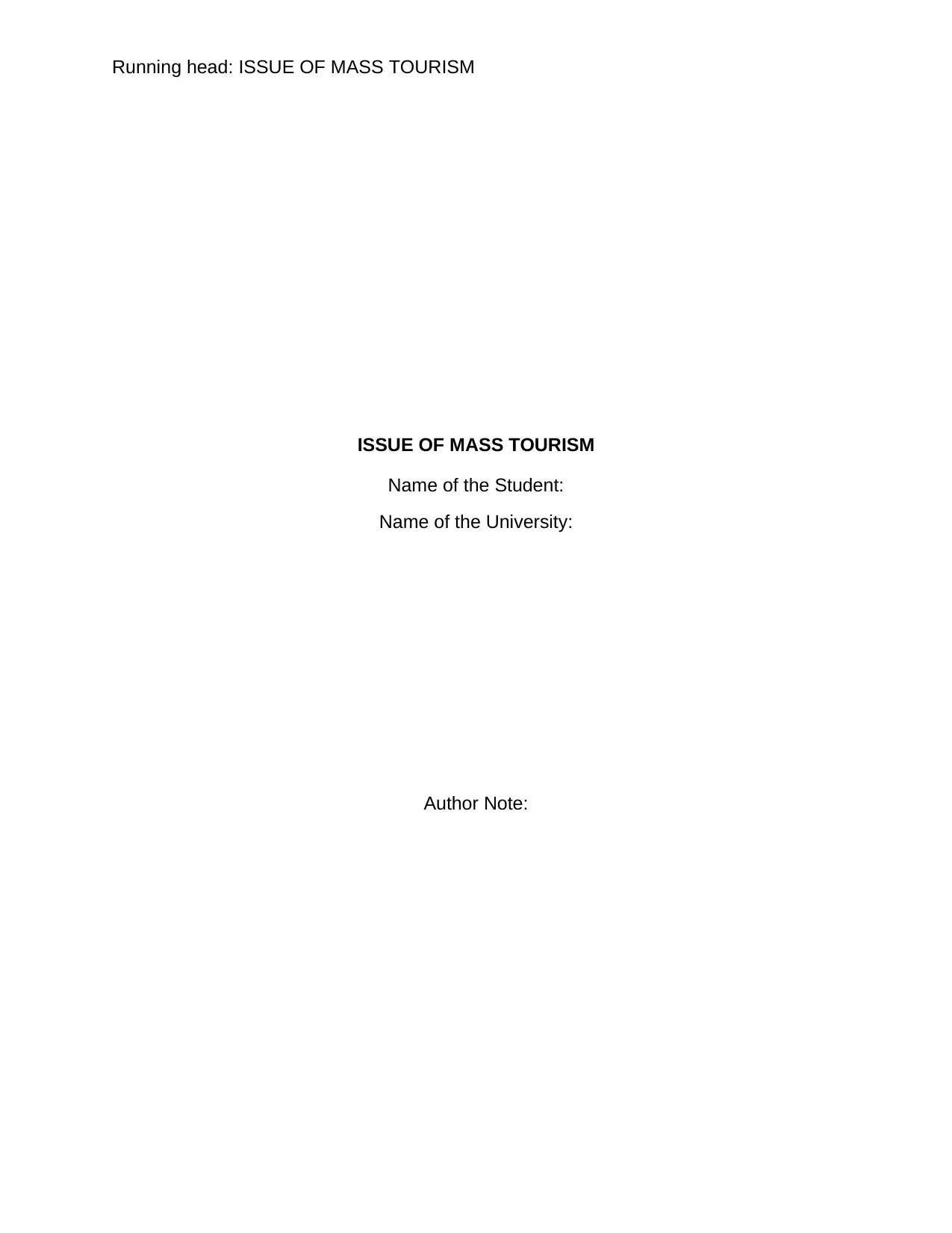
Running head: ISSUE OF MASS TOURISM
ISSUE OF MASS TOURISM
Name of the Student:
Name of the University:
Author Note:
ISSUE OF MASS TOURISM
Name of the Student:
Name of the University:
Author Note:
Paraphrase This Document
Need a fresh take? Get an instant paraphrase of this document with our AI Paraphraser
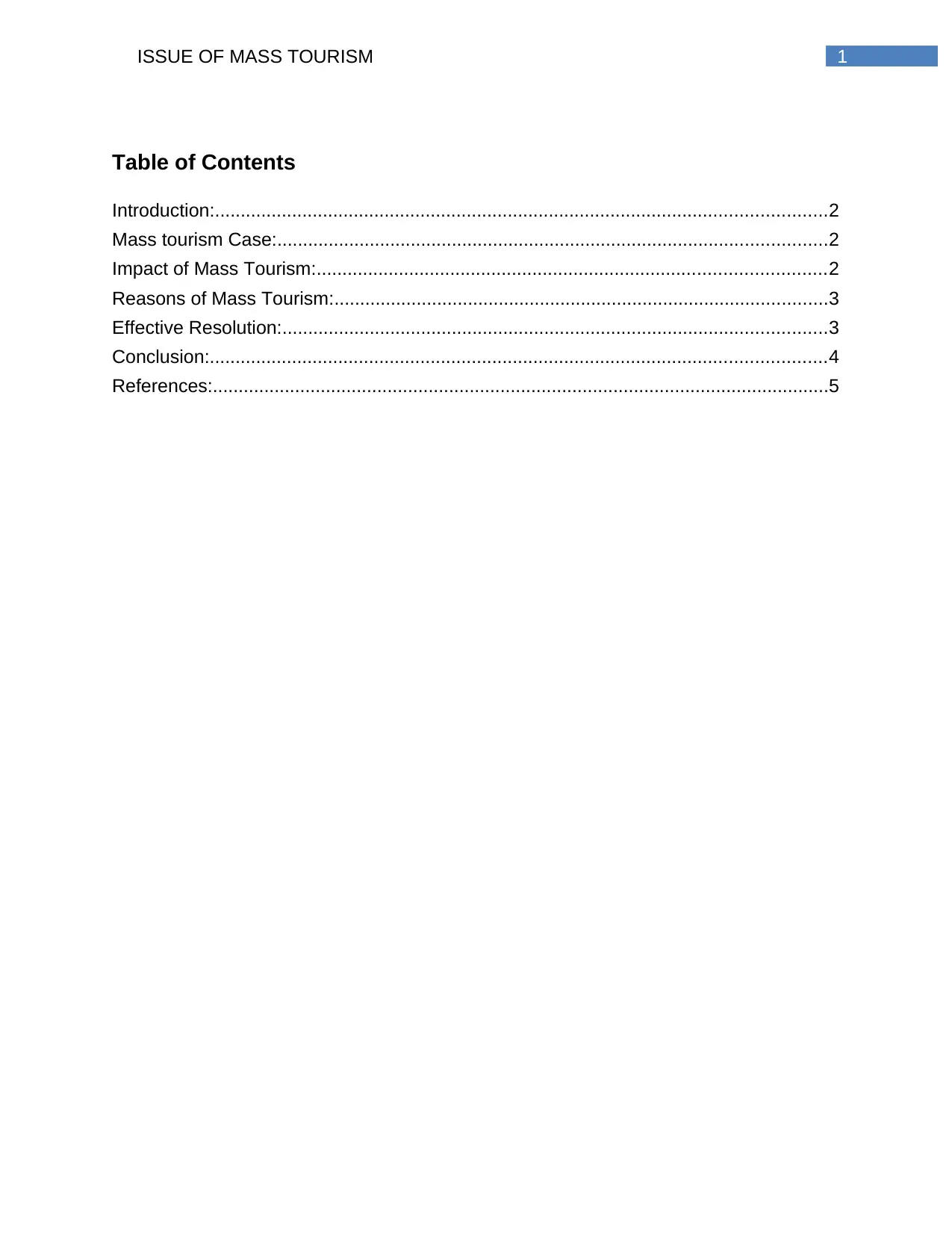
1ISSUE OF MASS TOURISM
Table of Contents
Introduction:.......................................................................................................................2
Mass tourism Case:...........................................................................................................2
Impact of Mass Tourism:...................................................................................................2
Reasons of Mass Tourism:................................................................................................3
Effective Resolution:..........................................................................................................3
Conclusion:........................................................................................................................4
References:........................................................................................................................5
Table of Contents
Introduction:.......................................................................................................................2
Mass tourism Case:...........................................................................................................2
Impact of Mass Tourism:...................................................................................................2
Reasons of Mass Tourism:................................................................................................3
Effective Resolution:..........................................................................................................3
Conclusion:........................................................................................................................4
References:........................................................................................................................5
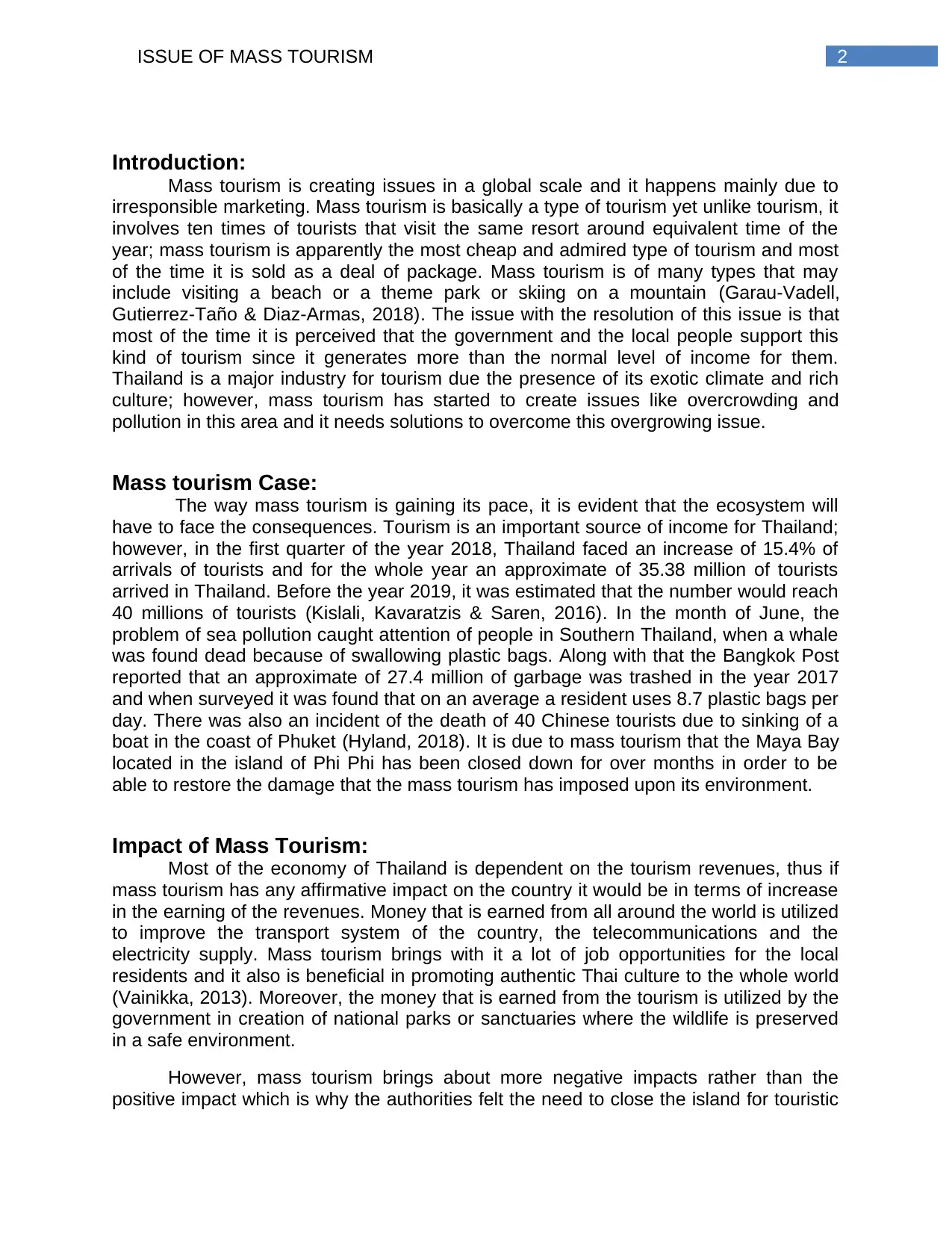
2ISSUE OF MASS TOURISM
Introduction:
Mass tourism is creating issues in a global scale and it happens mainly due to
irresponsible marketing. Mass tourism is basically a type of tourism yet unlike tourism, it
involves ten times of tourists that visit the same resort around equivalent time of the
year; mass tourism is apparently the most cheap and admired type of tourism and most
of the time it is sold as a deal of package. Mass tourism is of many types that may
include visiting a beach or a theme park or skiing on a mountain (Garau-Vadell,
Gutierrez-Taño & Diaz-Armas, 2018). The issue with the resolution of this issue is that
most of the time it is perceived that the government and the local people support this
kind of tourism since it generates more than the normal level of income for them.
Thailand is a major industry for tourism due the presence of its exotic climate and rich
culture; however, mass tourism has started to create issues like overcrowding and
pollution in this area and it needs solutions to overcome this overgrowing issue.
Mass tourism Case:
The way mass tourism is gaining its pace, it is evident that the ecosystem will
have to face the consequences. Tourism is an important source of income for Thailand;
however, in the first quarter of the year 2018, Thailand faced an increase of 15.4% of
arrivals of tourists and for the whole year an approximate of 35.38 million of tourists
arrived in Thailand. Before the year 2019, it was estimated that the number would reach
40 millions of tourists (Kislali, Kavaratzis & Saren, 2016). In the month of June, the
problem of sea pollution caught attention of people in Southern Thailand, when a whale
was found dead because of swallowing plastic bags. Along with that the Bangkok Post
reported that an approximate of 27.4 million of garbage was trashed in the year 2017
and when surveyed it was found that on an average a resident uses 8.7 plastic bags per
day. There was also an incident of the death of 40 Chinese tourists due to sinking of a
boat in the coast of Phuket (Hyland, 2018). It is due to mass tourism that the Maya Bay
located in the island of Phi Phi has been closed down for over months in order to be
able to restore the damage that the mass tourism has imposed upon its environment.
Impact of Mass Tourism:
Most of the economy of Thailand is dependent on the tourism revenues, thus if
mass tourism has any affirmative impact on the country it would be in terms of increase
in the earning of the revenues. Money that is earned from all around the world is utilized
to improve the transport system of the country, the telecommunications and the
electricity supply. Mass tourism brings with it a lot of job opportunities for the local
residents and it also is beneficial in promoting authentic Thai culture to the whole world
(Vainikka, 2013). Moreover, the money that is earned from the tourism is utilized by the
government in creation of national parks or sanctuaries where the wildlife is preserved
in a safe environment.
However, mass tourism brings about more negative impacts rather than the
positive impact which is why the authorities felt the need to close the island for touristic
Introduction:
Mass tourism is creating issues in a global scale and it happens mainly due to
irresponsible marketing. Mass tourism is basically a type of tourism yet unlike tourism, it
involves ten times of tourists that visit the same resort around equivalent time of the
year; mass tourism is apparently the most cheap and admired type of tourism and most
of the time it is sold as a deal of package. Mass tourism is of many types that may
include visiting a beach or a theme park or skiing on a mountain (Garau-Vadell,
Gutierrez-Taño & Diaz-Armas, 2018). The issue with the resolution of this issue is that
most of the time it is perceived that the government and the local people support this
kind of tourism since it generates more than the normal level of income for them.
Thailand is a major industry for tourism due the presence of its exotic climate and rich
culture; however, mass tourism has started to create issues like overcrowding and
pollution in this area and it needs solutions to overcome this overgrowing issue.
Mass tourism Case:
The way mass tourism is gaining its pace, it is evident that the ecosystem will
have to face the consequences. Tourism is an important source of income for Thailand;
however, in the first quarter of the year 2018, Thailand faced an increase of 15.4% of
arrivals of tourists and for the whole year an approximate of 35.38 million of tourists
arrived in Thailand. Before the year 2019, it was estimated that the number would reach
40 millions of tourists (Kislali, Kavaratzis & Saren, 2016). In the month of June, the
problem of sea pollution caught attention of people in Southern Thailand, when a whale
was found dead because of swallowing plastic bags. Along with that the Bangkok Post
reported that an approximate of 27.4 million of garbage was trashed in the year 2017
and when surveyed it was found that on an average a resident uses 8.7 plastic bags per
day. There was also an incident of the death of 40 Chinese tourists due to sinking of a
boat in the coast of Phuket (Hyland, 2018). It is due to mass tourism that the Maya Bay
located in the island of Phi Phi has been closed down for over months in order to be
able to restore the damage that the mass tourism has imposed upon its environment.
Impact of Mass Tourism:
Most of the economy of Thailand is dependent on the tourism revenues, thus if
mass tourism has any affirmative impact on the country it would be in terms of increase
in the earning of the revenues. Money that is earned from all around the world is utilized
to improve the transport system of the country, the telecommunications and the
electricity supply. Mass tourism brings with it a lot of job opportunities for the local
residents and it also is beneficial in promoting authentic Thai culture to the whole world
(Vainikka, 2013). Moreover, the money that is earned from the tourism is utilized by the
government in creation of national parks or sanctuaries where the wildlife is preserved
in a safe environment.
However, mass tourism brings about more negative impacts rather than the
positive impact which is why the authorities felt the need to close the island for touristic
⊘ This is a preview!⊘
Do you want full access?
Subscribe today to unlock all pages.

Trusted by 1+ million students worldwide
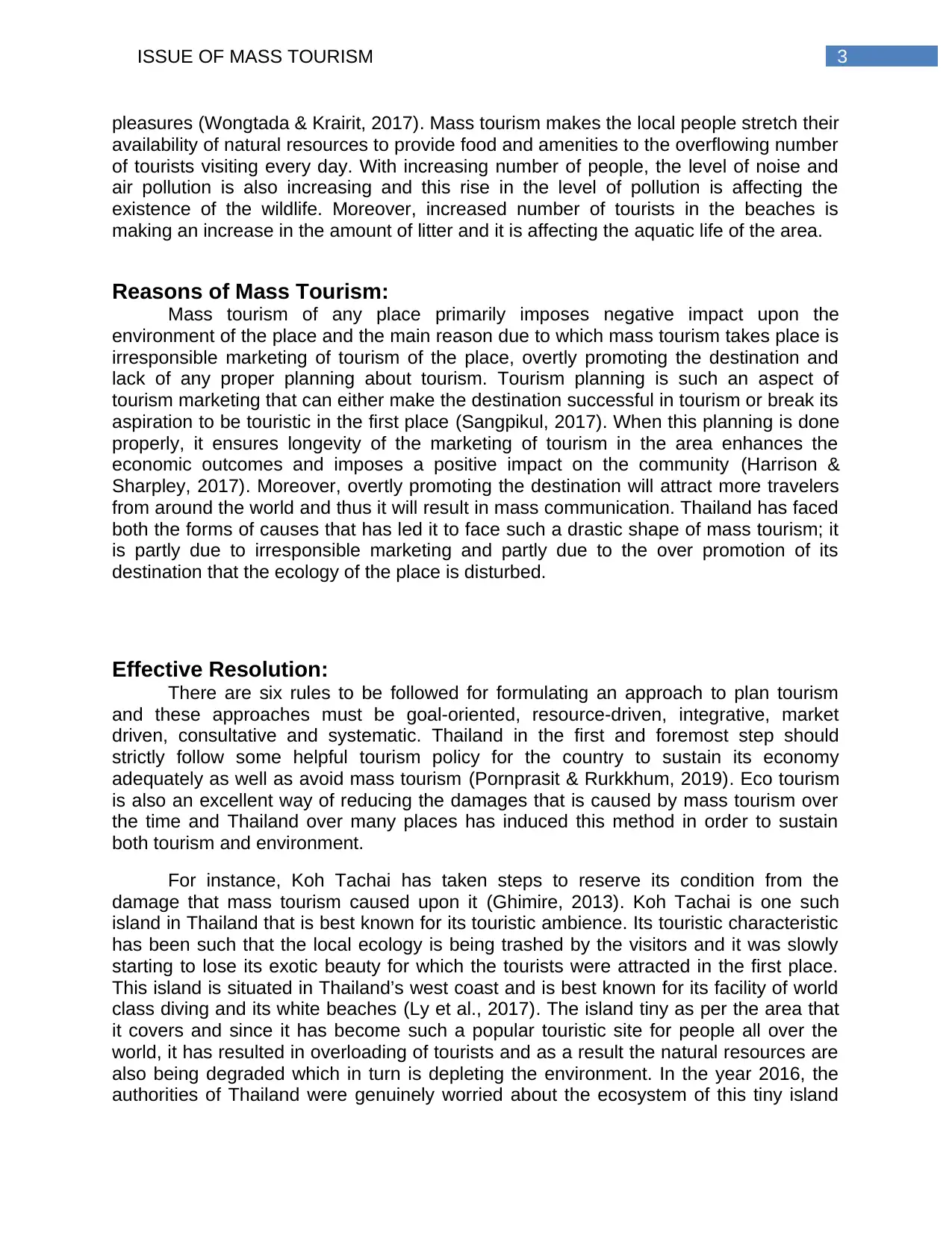
3ISSUE OF MASS TOURISM
pleasures (Wongtada & Krairit, 2017). Mass tourism makes the local people stretch their
availability of natural resources to provide food and amenities to the overflowing number
of tourists visiting every day. With increasing number of people, the level of noise and
air pollution is also increasing and this rise in the level of pollution is affecting the
existence of the wildlife. Moreover, increased number of tourists in the beaches is
making an increase in the amount of litter and it is affecting the aquatic life of the area.
Reasons of Mass Tourism:
Mass tourism of any place primarily imposes negative impact upon the
environment of the place and the main reason due to which mass tourism takes place is
irresponsible marketing of tourism of the place, overtly promoting the destination and
lack of any proper planning about tourism. Tourism planning is such an aspect of
tourism marketing that can either make the destination successful in tourism or break its
aspiration to be touristic in the first place (Sangpikul, 2017). When this planning is done
properly, it ensures longevity of the marketing of tourism in the area enhances the
economic outcomes and imposes a positive impact on the community (Harrison &
Sharpley, 2017). Moreover, overtly promoting the destination will attract more travelers
from around the world and thus it will result in mass communication. Thailand has faced
both the forms of causes that has led it to face such a drastic shape of mass tourism; it
is partly due to irresponsible marketing and partly due to the over promotion of its
destination that the ecology of the place is disturbed.
Effective Resolution:
There are six rules to be followed for formulating an approach to plan tourism
and these approaches must be goal-oriented, resource-driven, integrative, market
driven, consultative and systematic. Thailand in the first and foremost step should
strictly follow some helpful tourism policy for the country to sustain its economy
adequately as well as avoid mass tourism (Pornprasit & Rurkkhum, 2019). Eco tourism
is also an excellent way of reducing the damages that is caused by mass tourism over
the time and Thailand over many places has induced this method in order to sustain
both tourism and environment.
For instance, Koh Tachai has taken steps to reserve its condition from the
damage that mass tourism caused upon it (Ghimire, 2013). Koh Tachai is one such
island in Thailand that is best known for its touristic ambience. Its touristic characteristic
has been such that the local ecology is being trashed by the visitors and it was slowly
starting to lose its exotic beauty for which the tourists were attracted in the first place.
This island is situated in Thailand’s west coast and is best known for its facility of world
class diving and its white beaches (Ly et al., 2017). The island tiny as per the area that
it covers and since it has become such a popular touristic site for people all over the
world, it has resulted in overloading of tourists and as a result the natural resources are
also being degraded which in turn is depleting the environment. In the year 2016, the
authorities of Thailand were genuinely worried about the ecosystem of this tiny island
pleasures (Wongtada & Krairit, 2017). Mass tourism makes the local people stretch their
availability of natural resources to provide food and amenities to the overflowing number
of tourists visiting every day. With increasing number of people, the level of noise and
air pollution is also increasing and this rise in the level of pollution is affecting the
existence of the wildlife. Moreover, increased number of tourists in the beaches is
making an increase in the amount of litter and it is affecting the aquatic life of the area.
Reasons of Mass Tourism:
Mass tourism of any place primarily imposes negative impact upon the
environment of the place and the main reason due to which mass tourism takes place is
irresponsible marketing of tourism of the place, overtly promoting the destination and
lack of any proper planning about tourism. Tourism planning is such an aspect of
tourism marketing that can either make the destination successful in tourism or break its
aspiration to be touristic in the first place (Sangpikul, 2017). When this planning is done
properly, it ensures longevity of the marketing of tourism in the area enhances the
economic outcomes and imposes a positive impact on the community (Harrison &
Sharpley, 2017). Moreover, overtly promoting the destination will attract more travelers
from around the world and thus it will result in mass communication. Thailand has faced
both the forms of causes that has led it to face such a drastic shape of mass tourism; it
is partly due to irresponsible marketing and partly due to the over promotion of its
destination that the ecology of the place is disturbed.
Effective Resolution:
There are six rules to be followed for formulating an approach to plan tourism
and these approaches must be goal-oriented, resource-driven, integrative, market
driven, consultative and systematic. Thailand in the first and foremost step should
strictly follow some helpful tourism policy for the country to sustain its economy
adequately as well as avoid mass tourism (Pornprasit & Rurkkhum, 2019). Eco tourism
is also an excellent way of reducing the damages that is caused by mass tourism over
the time and Thailand over many places has induced this method in order to sustain
both tourism and environment.
For instance, Koh Tachai has taken steps to reserve its condition from the
damage that mass tourism caused upon it (Ghimire, 2013). Koh Tachai is one such
island in Thailand that is best known for its touristic ambience. Its touristic characteristic
has been such that the local ecology is being trashed by the visitors and it was slowly
starting to lose its exotic beauty for which the tourists were attracted in the first place.
This island is situated in Thailand’s west coast and is best known for its facility of world
class diving and its white beaches (Ly et al., 2017). The island tiny as per the area that
it covers and since it has become such a popular touristic site for people all over the
world, it has resulted in overloading of tourists and as a result the natural resources are
also being degraded which in turn is depleting the environment. In the year 2016, the
authorities of Thailand were genuinely worried about the ecosystem of this tiny island
Paraphrase This Document
Need a fresh take? Get an instant paraphrase of this document with our AI Paraphraser
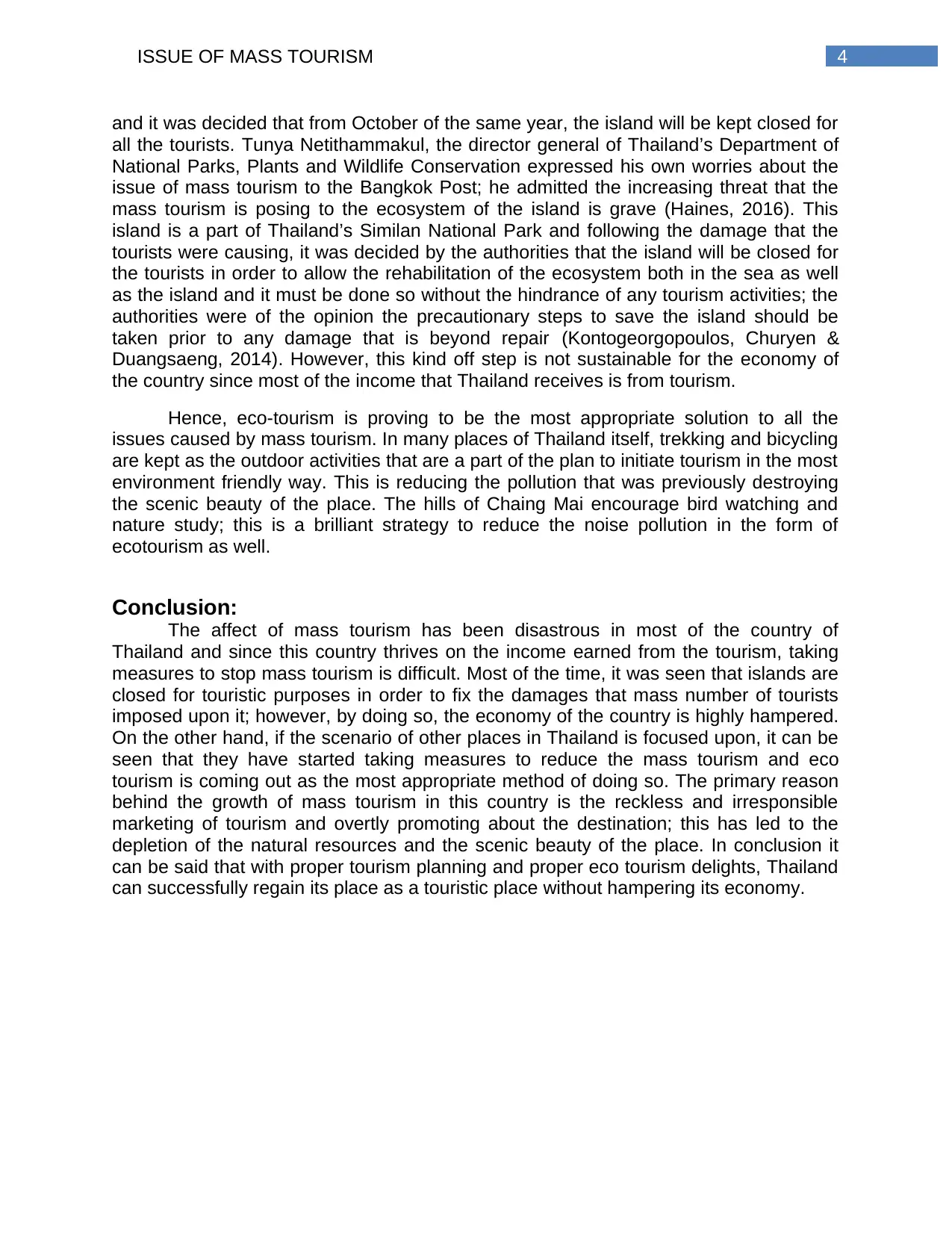
4ISSUE OF MASS TOURISM
and it was decided that from October of the same year, the island will be kept closed for
all the tourists. Tunya Netithammakul, the director general of Thailand’s Department of
National Parks, Plants and Wildlife Conservation expressed his own worries about the
issue of mass tourism to the Bangkok Post; he admitted the increasing threat that the
mass tourism is posing to the ecosystem of the island is grave (Haines, 2016). This
island is a part of Thailand’s Similan National Park and following the damage that the
tourists were causing, it was decided by the authorities that the island will be closed for
the tourists in order to allow the rehabilitation of the ecosystem both in the sea as well
as the island and it must be done so without the hindrance of any tourism activities; the
authorities were of the opinion the precautionary steps to save the island should be
taken prior to any damage that is beyond repair (Kontogeorgopoulos, Churyen &
Duangsaeng, 2014). However, this kind off step is not sustainable for the economy of
the country since most of the income that Thailand receives is from tourism.
Hence, eco-tourism is proving to be the most appropriate solution to all the
issues caused by mass tourism. In many places of Thailand itself, trekking and bicycling
are kept as the outdoor activities that are a part of the plan to initiate tourism in the most
environment friendly way. This is reducing the pollution that was previously destroying
the scenic beauty of the place. The hills of Chaing Mai encourage bird watching and
nature study; this is a brilliant strategy to reduce the noise pollution in the form of
ecotourism as well.
Conclusion:
The affect of mass tourism has been disastrous in most of the country of
Thailand and since this country thrives on the income earned from the tourism, taking
measures to stop mass tourism is difficult. Most of the time, it was seen that islands are
closed for touristic purposes in order to fix the damages that mass number of tourists
imposed upon it; however, by doing so, the economy of the country is highly hampered.
On the other hand, if the scenario of other places in Thailand is focused upon, it can be
seen that they have started taking measures to reduce the mass tourism and eco
tourism is coming out as the most appropriate method of doing so. The primary reason
behind the growth of mass tourism in this country is the reckless and irresponsible
marketing of tourism and overtly promoting about the destination; this has led to the
depletion of the natural resources and the scenic beauty of the place. In conclusion it
can be said that with proper tourism planning and proper eco tourism delights, Thailand
can successfully regain its place as a touristic place without hampering its economy.
and it was decided that from October of the same year, the island will be kept closed for
all the tourists. Tunya Netithammakul, the director general of Thailand’s Department of
National Parks, Plants and Wildlife Conservation expressed his own worries about the
issue of mass tourism to the Bangkok Post; he admitted the increasing threat that the
mass tourism is posing to the ecosystem of the island is grave (Haines, 2016). This
island is a part of Thailand’s Similan National Park and following the damage that the
tourists were causing, it was decided by the authorities that the island will be closed for
the tourists in order to allow the rehabilitation of the ecosystem both in the sea as well
as the island and it must be done so without the hindrance of any tourism activities; the
authorities were of the opinion the precautionary steps to save the island should be
taken prior to any damage that is beyond repair (Kontogeorgopoulos, Churyen &
Duangsaeng, 2014). However, this kind off step is not sustainable for the economy of
the country since most of the income that Thailand receives is from tourism.
Hence, eco-tourism is proving to be the most appropriate solution to all the
issues caused by mass tourism. In many places of Thailand itself, trekking and bicycling
are kept as the outdoor activities that are a part of the plan to initiate tourism in the most
environment friendly way. This is reducing the pollution that was previously destroying
the scenic beauty of the place. The hills of Chaing Mai encourage bird watching and
nature study; this is a brilliant strategy to reduce the noise pollution in the form of
ecotourism as well.
Conclusion:
The affect of mass tourism has been disastrous in most of the country of
Thailand and since this country thrives on the income earned from the tourism, taking
measures to stop mass tourism is difficult. Most of the time, it was seen that islands are
closed for touristic purposes in order to fix the damages that mass number of tourists
imposed upon it; however, by doing so, the economy of the country is highly hampered.
On the other hand, if the scenario of other places in Thailand is focused upon, it can be
seen that they have started taking measures to reduce the mass tourism and eco
tourism is coming out as the most appropriate method of doing so. The primary reason
behind the growth of mass tourism in this country is the reckless and irresponsible
marketing of tourism and overtly promoting about the destination; this has led to the
depletion of the natural resources and the scenic beauty of the place. In conclusion it
can be said that with proper tourism planning and proper eco tourism delights, Thailand
can successfully regain its place as a touristic place without hampering its economy.
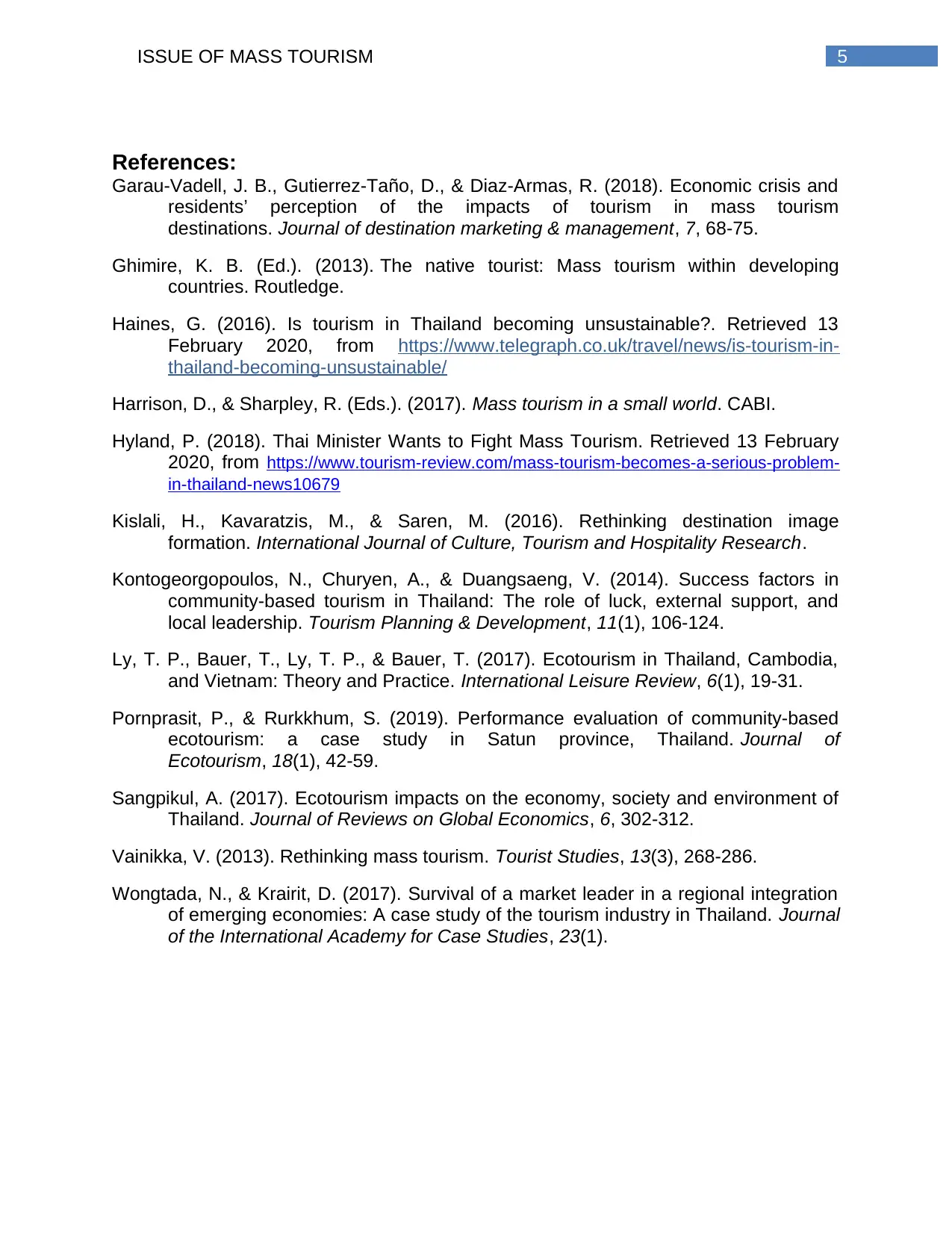
5ISSUE OF MASS TOURISM
References:
Garau-Vadell, J. B., Gutierrez-Taño, D., & Diaz-Armas, R. (2018). Economic crisis and
residents’ perception of the impacts of tourism in mass tourism
destinations. Journal of destination marketing & management, 7, 68-75.
Ghimire, K. B. (Ed.). (2013). The native tourist: Mass tourism within developing
countries. Routledge.
Haines, G. (2016). Is tourism in Thailand becoming unsustainable?. Retrieved 13
February 2020, from https://www.telegraph.co.uk/travel/news/is-tourism-in-
thailand-becoming-unsustainable/
Harrison, D., & Sharpley, R. (Eds.). (2017). Mass tourism in a small world. CABI.
Hyland, P. (2018). Thai Minister Wants to Fight Mass Tourism. Retrieved 13 February
2020, from https://www.tourism-review.com/mass-tourism-becomes-a-serious-problem-
in-thailand-news10679
Kislali, H., Kavaratzis, M., & Saren, M. (2016). Rethinking destination image
formation. International Journal of Culture, Tourism and Hospitality Research.
Kontogeorgopoulos, N., Churyen, A., & Duangsaeng, V. (2014). Success factors in
community-based tourism in Thailand: The role of luck, external support, and
local leadership. Tourism Planning & Development, 11(1), 106-124.
Ly, T. P., Bauer, T., Ly, T. P., & Bauer, T. (2017). Ecotourism in Thailand, Cambodia,
and Vietnam: Theory and Practice. International Leisure Review, 6(1), 19-31.
Pornprasit, P., & Rurkkhum, S. (2019). Performance evaluation of community-based
ecotourism: a case study in Satun province, Thailand. Journal of
Ecotourism, 18(1), 42-59.
Sangpikul, A. (2017). Ecotourism impacts on the economy, society and environment of
Thailand. Journal of Reviews on Global Economics, 6, 302-312.
Vainikka, V. (2013). Rethinking mass tourism. Tourist Studies, 13(3), 268-286.
Wongtada, N., & Krairit, D. (2017). Survival of a market leader in a regional integration
of emerging economies: A case study of the tourism industry in Thailand. Journal
of the International Academy for Case Studies, 23(1).
References:
Garau-Vadell, J. B., Gutierrez-Taño, D., & Diaz-Armas, R. (2018). Economic crisis and
residents’ perception of the impacts of tourism in mass tourism
destinations. Journal of destination marketing & management, 7, 68-75.
Ghimire, K. B. (Ed.). (2013). The native tourist: Mass tourism within developing
countries. Routledge.
Haines, G. (2016). Is tourism in Thailand becoming unsustainable?. Retrieved 13
February 2020, from https://www.telegraph.co.uk/travel/news/is-tourism-in-
thailand-becoming-unsustainable/
Harrison, D., & Sharpley, R. (Eds.). (2017). Mass tourism in a small world. CABI.
Hyland, P. (2018). Thai Minister Wants to Fight Mass Tourism. Retrieved 13 February
2020, from https://www.tourism-review.com/mass-tourism-becomes-a-serious-problem-
in-thailand-news10679
Kislali, H., Kavaratzis, M., & Saren, M. (2016). Rethinking destination image
formation. International Journal of Culture, Tourism and Hospitality Research.
Kontogeorgopoulos, N., Churyen, A., & Duangsaeng, V. (2014). Success factors in
community-based tourism in Thailand: The role of luck, external support, and
local leadership. Tourism Planning & Development, 11(1), 106-124.
Ly, T. P., Bauer, T., Ly, T. P., & Bauer, T. (2017). Ecotourism in Thailand, Cambodia,
and Vietnam: Theory and Practice. International Leisure Review, 6(1), 19-31.
Pornprasit, P., & Rurkkhum, S. (2019). Performance evaluation of community-based
ecotourism: a case study in Satun province, Thailand. Journal of
Ecotourism, 18(1), 42-59.
Sangpikul, A. (2017). Ecotourism impacts on the economy, society and environment of
Thailand. Journal of Reviews on Global Economics, 6, 302-312.
Vainikka, V. (2013). Rethinking mass tourism. Tourist Studies, 13(3), 268-286.
Wongtada, N., & Krairit, D. (2017). Survival of a market leader in a regional integration
of emerging economies: A case study of the tourism industry in Thailand. Journal
of the International Academy for Case Studies, 23(1).
⊘ This is a preview!⊘
Do you want full access?
Subscribe today to unlock all pages.

Trusted by 1+ million students worldwide
1 out of 6
Related Documents
Your All-in-One AI-Powered Toolkit for Academic Success.
+13062052269
info@desklib.com
Available 24*7 on WhatsApp / Email
![[object Object]](/_next/static/media/star-bottom.7253800d.svg)
Unlock your academic potential
Copyright © 2020–2025 A2Z Services. All Rights Reserved. Developed and managed by ZUCOL.





